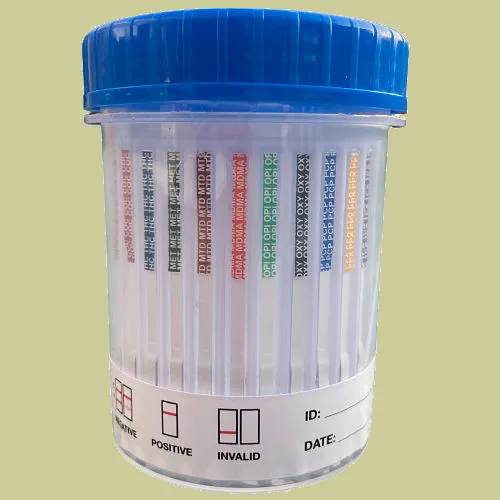Drug testing is an important tool for employers to promote a safe and healthy working environment. When considering implementing drug screening, one key decision is choosing the right testing panel. A panel refers to the specific drugs or drug families screened for in a single test. The more panels, the wider the range of drugs detected. A 18-panel drug test casts a very wide net to catch users of many common illicit and prescription substances. Read on to learn exactly what a 18-panel test looks for.
The Drugs Included On The 18-Panel Test
A 18-panel urine drug test checks for the following 18 drugs:
- Amphetamines – Speed
- Barbiturates – Phenobarbital, butalbital
- Benzodiazepines – Valium, Xanax, Klonopin
- Buprenorphine – Subutex, suboxone
- Cannabis – Marijuana, hash, shatter
- Cocaine – Cocaine, crack
- Cotinine – Metabolite of nicotine
- Ecstasy / MDMA
- Fentanyl – Actiq, duragesic
- Ketamine – Special K
- Methadone
- Methamphetamine – Crystal meth, ice
- Opiates – Heroin, morphine, codeine
- Oxycodone – Oxycontin, Percocet
- PCP – Angel dust
- Propoxyphene – Darvon
- Tramadol
- Tricyclic antidepressants – Amitriptyline, desipramine
This extensive panel covers all major drug groups including stimulants, depressants, hallucinogens, and opioids. Both illicit drugs and commonly abused prescription medications are included.
Why Use A 18-Panel Test?
There are several reasons an employer may choose a 18-panel drug screen for pre-employment testing or random workplace screening:
- Casts a wider net to detect more substances of abuse. People often take multiple drugs, so a broader test increases chances of catching drug use.
- Catches new or emerging drugs like synthetic cannabinoids and fentanyl. These aren’t in standard 5 or 10 panel tests.
- Screens for commonly abused prescription meds like benzodiazepines, oxycodone, and tramadol. These are widely misused but not typically tested for.
- Meets testing requirements for safety-sensitive positions like healthcare, transportation, and public safety. Most require testing for opioids.
- Deters people from trying to “beat” a drug test. With more drugs covered, there are fewer options to try masking or diluting certain substances.
In summary, a wide screening range is useful for employers who want maximum detection of illicit and prescription drug use.
More About 18-Panel Drug Testing
For employers truly committed to a drug-free workplace, the 18-panel test provides the broadest screening available. This comprehensive panel leaves few places to hide for those abusing substances.
Whether licit or illicit, commonly abused prescription meds or street drugs – the 18-panel aims to catch them all. You gain peace of mind knowing your workforce isn’t impaired by everything from Xanax to PCP.
However, this extensive testing does come at a higher cost. The added panels and confirmations make 18-panel screens more expensive than basic 5 or 10-panel tests. But for safety-critical industries like transportation, construction, and healthcare, the investment is well worth it. An impaired employee could potentially put many lives at risk.
So while not every workplace requires this level of screening, the 18-panel drug test is an excellent option for those prioritising a truly drug-free environment. The broader detection capabilities allow you to uphold the highest standards for workplace safety and productivity.
How 18-Panel Drug Tests Work
Most 18-panel tests analyse a urine sample, as urine testing is simple to administer and detects recent drug use. The procedure is straightforward:
- The donor provides a urine sample at a collection site or with an at-home test kit.
- The sample is screened for the 18 drugs using immunoassay technology.
- If positive for any drug, the sample will undergo confirmatory GC/MS testing to validate the result.
- The final positive or negative result for each substance is reported to the employer.
Like other multi-panel urine drug tests, a 18-panel screen combines multiple immunoassays into one test. This allows it to check for many drugs at once while using only a small sample volume.
GC/MS confirmation checks for the specific chemical signatures of each drug or metabolite. This eliminates false positives from cross-reactivity with similar compounds. The end result is an accurate and legally defensible test result.
Considerations When Choosing A Drug Test Panel
When deciding whether to use a standard 5-panel or expanded 13-panel test, keep the following in mind:
- Broader isn’t always better. Use the minimum panel that tests for your drug of concern.
- Know the common drugs abused in your industry or region. A 10-panel may suit a transportation company, while a 5-panel works for an office.
- Consider the costs. Larger panels cost more since they use additional reagents.
- Choose urine, oral fluid, hair, or other specimen testing to fit your needs. Each has pros and cons.
- Review the turnaround time for results. More substances may mean longer lab processing time.
- Select a lab accredited to legally confirm results. This ensures proof of use for any disciplinary action.
In summary, larger drug test panels cast a wider net but may not be necessary depending on your workforce and goals. Carefully evaluate what you want to accomplish, and choose the panel that’s right for your drug testing programme.
Photo: “18 Panel Urine Drug Test” by Anthony Cunningham for Zoom Testing
Zoom Testing is a leading UK drug testing company and a supplier of Drug Test Kits.





